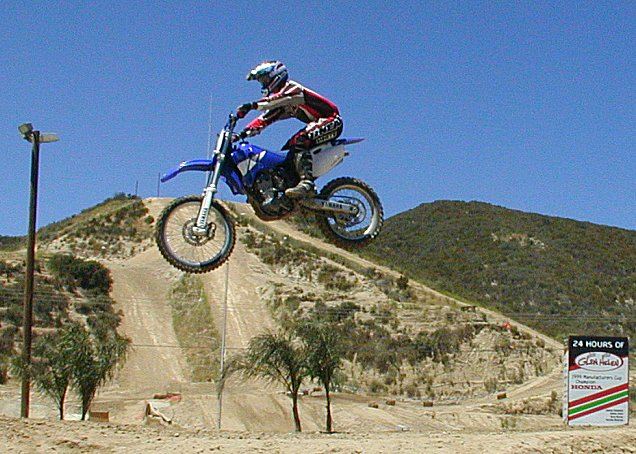
I was invited to Glen Helen Motocross Park yesterday for Yamaha’s 2001 motocross and off road bike introduction. The star of the show, in my mind, was the YZ250F four-stroke (some still photos of the bike were posted in our article dated June 6, 2000). This bike is legal in the AMA 125 two-stroke class, and it will be raced in that class (both supercross and outdoor motocross) by Yamaha next year. In addition to learning details about this bike and its performance potential, I had the chance to photograph Yamaha’s Doug Dubach riding the YZ250F, and I also had the chance to interview Doug. Doug knows more about the performance of this exciting new four-stroke than anyone, because Doug has been the principal test rider for the machine for the last year and one-half. Aside from being a very nice guy, Doug is a former Yamaha factory rider, and is still capable of a top ten finish in an AMA Outdoor National event.
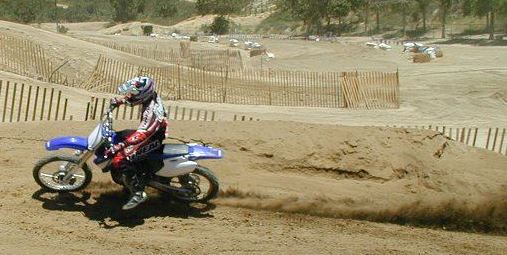
Although Doug is paid by Yamaha as a test rider (and is definitely a loyal, Yamaha guy), I lend great credence to his comments about the YZ250F. Yamaha doesn’t want to detract from its bread-and-butter sellers, the YZ125 and YZ250 two-strokes. For this reason, I felt Doug was, in some instances, understating how good this bike is.
As I watched Doug ride the YZ250F, two things became very obvious. First, the bike puts out a lot of thrust exiting corners — clearly more than a 125 two-stroke (look at the roost coming from Doug’s rear wheel in some of the photos). It also appeared to be easy to ride — something Doug stressed (claiming it was the easiest motocross bike to ride that he has ever ridden — it just doesn’t tire you out). Here is part of my conversation with Doug Dubach about the 2001 YZ250F.
MD
Doug, you said you have been testing the new Yamaha 250 four-stroke for about two years now?
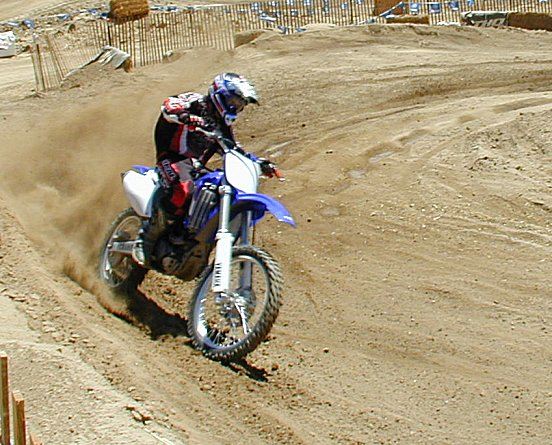
Dubach
Yeah, about a year and a half we’ve had it here in the U.S. The project got started not long after the 400 was released. We rode that for again a couple of years. I think we had it in mid-1996 and then we released in it 1998. So, then I believe not too long, maybe mid-1998, late-1998, they were working on the 250 and then we had it right at the end of 1998 — we saw the first 250 four-stroke.
MD
So you’ve been riding it in pre-production form for over a year then.
Dubach
Yeah, we’ve had a couple of different — it goes in steps, it usually goes like pre-prototype, then prototype, then pre-production and then actual production bikes follow. So, yeah, we’ve been riding it — it hasn’t changed much. They’ve learned so much from the 400/426 that you know there’s just the obvious [refinements], a little bit of carburetion or maybe a different exhaust pipe or whatnot, but yeah, we’ve had very, very few little teething troubles with that 250.
MD
When did the 250 motor get finalized for production?
Dubach
We completed our durability [testing] just last month, and although there are other little final details [to change], whether it’s carburetion setting or something along those lines, as far as the actual spec, that was pretty much it — you know, the stamp got put in the folder so to speak once we completed our durability side of it.
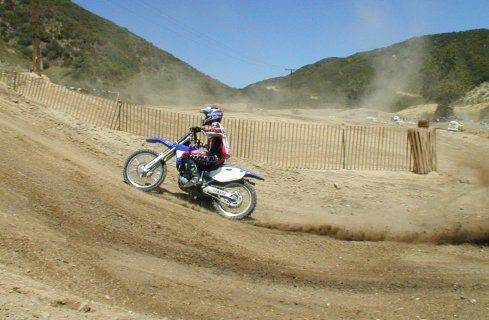
MD
Compare the powerband of the YZ250F to a 125 two-stroke.
Dubach
Well, you know, our 125 two-stroke has kind of set the standard as far as two-stroke 125s go with a good bottom and mid-range power. But generally across the board, when you picture a 125, you picture not so much bottom throttle control, but good mid to top and over rev. Well, with this, it’s got a lot more bottom than a two-stroke 125 — I don’t want to say ours, but it’s got more bottom and more torque and then it revs — actually 13,500 rpm is the rev limit — that’s just where the ignition cuts it off. It’ll go further, but for the durability side of it [it’s limited] and you know a 125 two-stroke — I don’t care who you are or what engine builder you are — I don’t think you can get more than about 10,500 or 11,000 rpm out of a two-stroke.
MD
So you’re shifting a lot less on the 250 four-stroke than you would on a 125 two-stroke?
Dubach
Yeah, you know, I think anyone that’s familiar with riding a 250 two-stroke compared to a 400/426, that is a comment a lot of people came back with . . . “How come you never have to shift the thing? It’s got such broad and wide power.” Well, again, that does apply [comparing the] 125 two-stroke to the 250 four-stroke. It does have — you know, the power begins sooner and it lasts a lot longer.
MD
Now, you commented earlier that the YZ250F is the most fun bike you’ve ever ridden. On a motocross track, does it feel as flickable as a 125 two-stroke, does it change directions as easily?
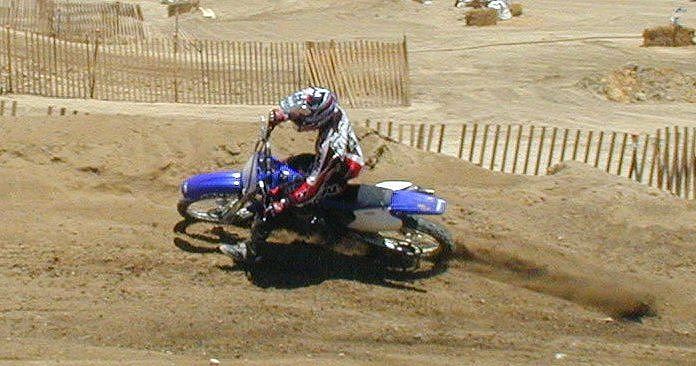
Dubach
I think it does. It’s obviously a few pounds heavier than a 125 two-stroke, but it is — this is still pre-production claims — it’s a pound lighter than our current 250 two-stroke. So that’s a really phenomenal number to get it down in that kind of a weight range, and it’s very flickable [on the track]. Especially if you’ve ridden either the 250 two-stroke or 400/426 because again, it’s like making that step from the 250 back to the 125. Plus, with the four-stroke engine character, you’ve got more front wheel traction due to the engine braking. You’ve got more rear wheel control due to the four-stroke engine character, so I can move around on the race track better on [the YZ250F] than I can on a 125 just because you’ve got the traction to make these cuts that you wouldn’t normally on a two-stroke.
MD
Now, speaking for myself, I’ve raced some vet class amateur motocross — I work behind a desk all week, and I’m not in the best shape and the 426 on some tracks would be too much bike. For a guy like me, maybe the 250 four-stroke would be the perfect bike.
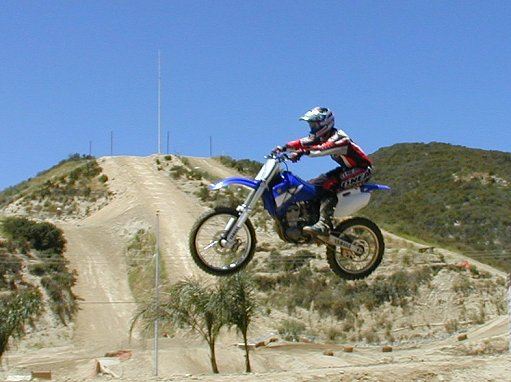
Dubach
Yeah, that’s actually a comment that I heard from a dealer. That not everyone is in as good of shape as a top pro rider, and that’s where this is going to be so kind to those kinds of people. You know, whereas a 250 two-stroke or a 426 might be, you know, geared for the guy that’s a little more fit, this will be, you know, a little more conducive to the guy that does sit behind the desk and push his pencil, but still wants to get out on the weekend and race with his buddies.
MD
I’ve heard some comments that this bike is even competitive against a 250 two-stroke.
Dubach
Yeah, lap times-wise it certainly is. You know, I won’t say that it’s faster because in a long start or up a hill or whatever, a 250 two-stroke will have the advantage, but you know, it will hold its own and it’s got a little more rear wheel traction and front wheel traction. You know, some of these advantages that a four-stroke has, I think you’d be surprised at just how competitive you will be in 250 class.
MD
Thanks for your time, Doug
Dubach
Thanks.





